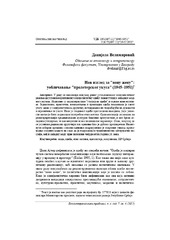Приказ основних података о документу
Nov izgled za 'novu ženu' - uobličavanje 'proleterskog ukusa' - 1945-1951
A new look for 'the new woman': The shaping of 'proletarian taste': 1945-1951
| dc.creator | Velimirović, Danijela | |
| dc.date.accessioned | 2021-10-12T11:29:22Z | |
| dc.date.available | 2021-10-12T11:29:22Z | |
| dc.date.issued | 2012 | |
| dc.identifier.issn | 0353-1589 | |
| dc.identifier.uri | http://reff.f.bg.ac.rs/handle/123456789/1381 | |
| dc.description.abstract | U radu se analizira pokušaj ranog jugoslovenskog komunističkog režima da ustanovi originalnu socijalističku odeću izvan uticaja zapadnog modnog sistema. Ispitane su karakteristike 'utopijske odeće' i osnove nove estetike. Jednostavna, praktična, nenametljiva i prikladna odeća pokazivala je svetu ulogu žena u socijalističkom društvu, istovremeno ih podsećajući na dužnosti i ograničenja te uloge. Iako je gizdavost odeće proglašena nazadnom, ukus javnosti mogao je biti zadovoljen upotrebom etno motiva. Ornamentacija zasnovana na reinterpretaciji tradicionalne kulturne baštine protumačena je kao brana zapadnim uticajima, te kao vizuelni iskaz nacionalne harmonije. Ipak, pokušaj da se ustanovi radikalno drugačiji tok odevanja bio je duboko protivrečan. Nametnuti zaborav prošlih stilova odevanja podrazumevao je osvrtanje unazad: proizvodnja uzornih modela ne samo da je podražavala tradicionalno materijalno nasleđe, već i zapadnu modu prve polovine četrdesetih godina 20. veka. | sr |
| dc.description.abstract | The post-war 'new woman' was supposed to reject fashion as a cultural practice of the decadent bourgeois world. The paper analyzes the attempt made by the Yugoslav communist regime to establish original socialist clothing outside the influence of western systems of fashion. I will explore the characteristics of 'utopian clothing' and the bases of a new aesthetic. Simple, practical, unobtrusive and appropriate clothing displayed the role of women in socialist society to the world at large, at the same time reminding women of the duties and limitations which came with the role. Even though gaudiness was declared backward, the public taste could be appeased through the use of ethno motives. Ornamentation based on the reinterpretation of traditional cultural heritage was interpreted as a defense against western influences as well as a visual display of national harmony. However, the attempt to establish a radically different course in fashion was deeply conflicting. The imposed oblivion towards old dress codes implied a look back: the production of exemplary styles mimicked not only traditional material heritage, but also western fashion of the early 1940's. | en |
| dc.publisher | Univerzitet u Beogradu - Filozofski fakultet - Odeljenje za etnologiju i antropologiju, Beograd | |
| dc.relation | info:eu-repo/grantAgreement/MESTD/Basic Research (BR or ON)/177018/RS// | |
| dc.rights | openAccess | |
| dc.rights.uri | https://creativecommons.org/licenses/by/4.0/ | |
| dc.source | Etnoantropološki problemi | |
| dc.subject | odeća | sr |
| dc.subject | NR Srbija | sr |
| dc.subject | moda | sr |
| dc.subject | komunizam | sr |
| dc.subject | ideologija | sr |
| dc.subject | etno motivi | sr |
| dc.subject | PR Serbia | en |
| dc.subject | ideology | en |
| dc.subject | fashion | en |
| dc.subject | ethno motives | en |
| dc.subject | communism | en |
| dc.subject | clothing | en |
| dc.title | Nov izgled za 'novu ženu' - uobličavanje 'proleterskog ukusa' - 1945-1951 | sr |
| dc.title | A new look for 'the new woman': The shaping of 'proletarian taste': 1945-1951 | en |
| dc.type | article | |
| dc.rights.license | BY | |
| dc.citation.epage | 955 | |
| dc.citation.issue | 4 | |
| dc.citation.other | 7(4): 935-955 | |
| dc.citation.rank | M24 | |
| dc.citation.spage | 935 | |
| dc.citation.volume | 7 | |
| dc.identifier.doi | 10.21301/eap.v7i4.3 | |
| dc.identifier.fulltext | http://reff.f.bg.ac.rs/bitstream/id/335/1378.pdf | |
| dc.type.version | publishedVersion |

